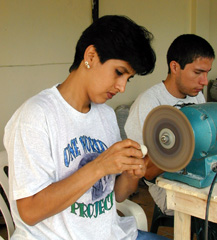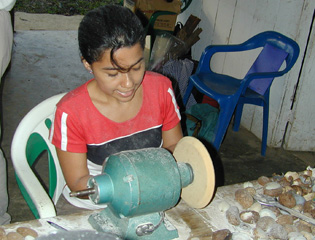Tagua nut is a rainforest nut known as vegetable ivory for its likeness to animal ivory. These are seeds that grow in pods called cabezas, from the tagua nut palm tree. Tagua's smooth, hard texture is an ideal medium for carving jewelry, boxes and other figurines or using the seed slices as beads for necklaces, bracelets and other craft projects.
Naya Nayon, an Ecuador-based NGO, counters poverty and deforestation by creating new jobs that depend on conservation and responsible forest management. The organization works with 23 local artisans, mostly working in home-based workshops to create several, beautiful objects from tagua nuts. These nuts grow year-round in Ecuador and can be harvested without causing any harm to the rainforest.
- Small measure 1-1/4” - 1-1/2”
- Medium measures 1-1/2”-1-3/4”
- Large measures 1-3/4” long or longer
White slices come in two thicknesses; standard slices are approximately 4mm thick, and the Thick slices are approximately 6 mm in thickness.
Natural tagua seed slices from Ecuador and fair trade imported.



Naya Nayon Artisan Story
Ecuador
 Naya Nayon, an Ecuador-based NGO, counters poverty and deforestation by creating new jobs that depend on conservation and responsible forest management. To accomplish this goal, the company works with 23 local artisans to create figurines, jewelry and ornaments from tagua nuts. These nuts grow year-round in Ecuador and can be harvested without detriment to the rainforest. Naya Nayon gives its artisans all the training, tools and materials they need to work from home, and then manages work distribution from the organizations main office to make sure orders are fairly distributed.
Naya Nayon, an Ecuador-based NGO, counters poverty and deforestation by creating new jobs that depend on conservation and responsible forest management. To accomplish this goal, the company works with 23 local artisans to create figurines, jewelry and ornaments from tagua nuts. These nuts grow year-round in Ecuador and can be harvested without detriment to the rainforest. Naya Nayon gives its artisans all the training, tools and materials they need to work from home, and then manages work distribution from the organizations main office to make sure orders are fairly distributed.
Naya Nayon's artisans work in home-based workshops throughout the country. Within each workshop, which is usually attached to an artisan's home, one artisan serves as the leader/manager and hires family members and friends to help produce products. New artisans begin by sanding and polishing figurines made by the more experienced artisans, and then gradually progress into the more complicated aspects of the craft, such as detailing, burning/coloring, and finally shaping the crude form of the nut. As demand and production increases, more artisans are invited to join the workshop. When the workshop grows to about 8 people, an experienced worker leaves to form a new workshop and train new artisans, and the cycle of learning continues.
Despite their humble backgrounds, many of Naya Nayon's artisans are highly educated with university degrees in engineering, law, business, and medicine. Unfortunately, Ecuador's shaky economy means jobs are scarce, even for highly-qualified professionals. Thankfully, Tagua nut carving has emerged as a sustainable alternative and is often the primary source of income for an artisan's family.